- Joined
- Oct 9, 2007
- Messages
- 47,194 (7.56/day)
- Location
- Hyderabad, India
| System Name | RBMK-1000 |
|---|---|
| Processor | AMD Ryzen 7 5700G |
| Motherboard | ASUS ROG Strix B450-E Gaming |
| Cooling | DeepCool Gammax L240 V2 |
| Memory | 2x 8GB G.Skill Sniper X |
| Video Card(s) | Palit GeForce RTX 2080 SUPER GameRock |
| Storage | Western Digital Black NVMe 512GB |
| Display(s) | BenQ 1440p 60 Hz 27-inch |
| Case | Corsair Carbide 100R |
| Audio Device(s) | ASUS SupremeFX S1220A |
| Power Supply | Cooler Master MWE Gold 650W |
| Mouse | ASUS ROG Strix Impact |
| Keyboard | Gamdias Hermes E2 |
| Software | Windows 11 Pro |
With leading motherboard manufacturers ready with their socket LGA1150 motherboards based on Intel's upcoming Zx7 Express chipset, ASRock joined in to unveil its offerings. ASRock's lineup includes five models based on the chipset. The most affordable of the lot will be the Zx7-Extreme4. This board offers an impressive 12-phase CPU VRM, two PCI-Express 3.0 x16 slots (x8/x8 when both are populated), one PCI-Express 2.0 x16 (electrical x4), and three PCI-Express 2.0 x1. Its storage connectivity includes eight SATA 6 Gb/s ports, from which two can mod into a SATA-Express connection with the conveniently placed SATA-E driver port; and one M.2 slot. Other features include Intel-made gigabit Ethernet, ASRock Purity sound with audio-grade capacitors and ground-layer isolation, and dual-UEFI BIOS. To not step on Gigabyte-held patents, ASRock's dual-BIOS implementation isn't automated, and you have to manually toggle between the two EEPROMs using a 2-way switch.

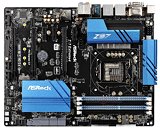
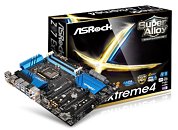
Next up, is the Zx7-E ITX. This little bad-boy will be one of the most feature-rich mini-ITX motherboards. Its feature-set includes a 6-phase CPU VRM, two DDR3 DIMM slots, a single PCI-Express 3.0 x16 slot, storage connectivity that includes six SATA 6 Gb/s, from which two mod-out to a SATA-Express port; six USB 3.0 ports, Intel-made gigabit Ethernet NIC, 8-channel HD audio with audio-grade capacitors, 802.11 ac + Bluetooth 4.0 WLAN, and display connectors that include one dual-link DVI, two HDMI, and one DisplayPort.

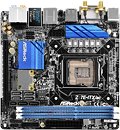
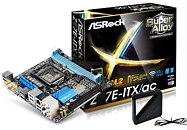
A notch above that, is the Zx7-Fatal1ty Killer. Geared for the crowd that thinks motherboards without a black and red color scheme can't play games, this board adds a few gamer-friendly features. To begin with, the LGA1150 socket is powered by a 10-phase VRM. It's wired to four DDR3 DIMM slots, and two PCI-Express 3.0 x16 slots (electrical x8/x8 when both are populated). Other expansion slots include two PCI-Express 2.0 x1, and two legacy PCI slots. ASRock's explanation for giving this board legacy PCI is that 10-year old PCI sound cards are still relevant today, because their output quality is still as good as it gets, even if their DSP features have become irrelevant. Storage connectivity that includes six SATA 6 Gb/s, from which two mod-out to a SATA-Express port; and an M.2, implemented in the same "superior" way as the rest of ASRock's lineup. You get the same 8-channel Purity audio as the Zx7-Extreme4, but the wired networking is care of a Killer E2200 NIC. Display connectivity includes dual-link DVI, D-Sub, and HDMI. Six USB 3.0 ports, and dual-UEFI BIOS make for the rest of it.

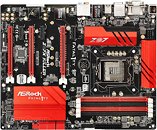
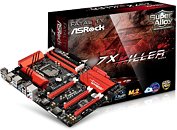
Moving on, the Zx7-Extreme6 is ASRock's most feature-rich offering in this lot. It features the same 12-phase CPU VRM as the Zx7-Extreme4, but the CPU is wired to three PCI-Express 3.0 x16 slots, (electrical x16/NC/NC or x8/x8/NC or x8/x4/x4). Storage connectivity includes ten SATA 6 Gb/s ports, from which two mod out to give a SATA-Express port; and two M.2 slots, one of which is what ASRock likes to call Ultra M.2 which is basically electrical x4 PCIe, and wired to the CPU's PCIe root complex, rather than that of the PCH. For existing M.2 SSDs it should mean lower latencies, but it should also make the board ready for future M.2 specification that's physical-layer PCIe 2.0 x4. There's also an eSATA 6 Gb/s. Display outputs include dual-link DVI, DisplayPort, and HDMI. Other features include two gigabit Ethernet ports, both driven by Intel-made controllers, 8-channel Purity 2 audio, and of course, dual-UEFI BIOS.

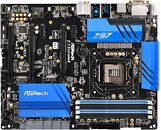
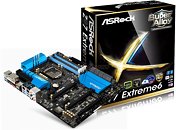
The other high-end board from ASRock is geared toward professional/competitive overclockers, the Zx7 OC Formula. This board features a strong CPU VRM, which draws power from not one, but two 8-pin EPS connectors apart from the 24-pin ATX, conditioning it over 12 phases, with high-grade components. To stabilize add-on card power planes, this board also draws power optionally from a 4-pin Molex. The four DDR3 DIMM slots are powered by a 4-phase memory VRM. Voltage measurement points are given out for nearly all power domains that matter to overclockers. Storage connectivity is identical to that of the Zx7-Extreme4. The expansion area includes four PCI-Express 3.0 x16 slots, from which we expect three to be wired out to the CPU, in the same manner as the Zx7-Extreme6, with the fourth slot being electrical x4, and wired to the PCH. Its only display output is an HDMI. Killer E2200 NIC, and Purity 2 audio make for the rest of its connectivity.

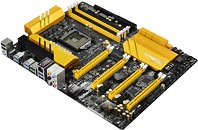
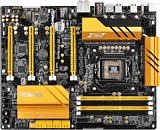
View at TechPowerUp Main Site



Next up, is the Zx7-E ITX. This little bad-boy will be one of the most feature-rich mini-ITX motherboards. Its feature-set includes a 6-phase CPU VRM, two DDR3 DIMM slots, a single PCI-Express 3.0 x16 slot, storage connectivity that includes six SATA 6 Gb/s, from which two mod-out to a SATA-Express port; six USB 3.0 ports, Intel-made gigabit Ethernet NIC, 8-channel HD audio with audio-grade capacitors, 802.11 ac + Bluetooth 4.0 WLAN, and display connectors that include one dual-link DVI, two HDMI, and one DisplayPort.



A notch above that, is the Zx7-Fatal1ty Killer. Geared for the crowd that thinks motherboards without a black and red color scheme can't play games, this board adds a few gamer-friendly features. To begin with, the LGA1150 socket is powered by a 10-phase VRM. It's wired to four DDR3 DIMM slots, and two PCI-Express 3.0 x16 slots (electrical x8/x8 when both are populated). Other expansion slots include two PCI-Express 2.0 x1, and two legacy PCI slots. ASRock's explanation for giving this board legacy PCI is that 10-year old PCI sound cards are still relevant today, because their output quality is still as good as it gets, even if their DSP features have become irrelevant. Storage connectivity that includes six SATA 6 Gb/s, from which two mod-out to a SATA-Express port; and an M.2, implemented in the same "superior" way as the rest of ASRock's lineup. You get the same 8-channel Purity audio as the Zx7-Extreme4, but the wired networking is care of a Killer E2200 NIC. Display connectivity includes dual-link DVI, D-Sub, and HDMI. Six USB 3.0 ports, and dual-UEFI BIOS make for the rest of it.



Moving on, the Zx7-Extreme6 is ASRock's most feature-rich offering in this lot. It features the same 12-phase CPU VRM as the Zx7-Extreme4, but the CPU is wired to three PCI-Express 3.0 x16 slots, (electrical x16/NC/NC or x8/x8/NC or x8/x4/x4). Storage connectivity includes ten SATA 6 Gb/s ports, from which two mod out to give a SATA-Express port; and two M.2 slots, one of which is what ASRock likes to call Ultra M.2 which is basically electrical x4 PCIe, and wired to the CPU's PCIe root complex, rather than that of the PCH. For existing M.2 SSDs it should mean lower latencies, but it should also make the board ready for future M.2 specification that's physical-layer PCIe 2.0 x4. There's also an eSATA 6 Gb/s. Display outputs include dual-link DVI, DisplayPort, and HDMI. Other features include two gigabit Ethernet ports, both driven by Intel-made controllers, 8-channel Purity 2 audio, and of course, dual-UEFI BIOS.



The other high-end board from ASRock is geared toward professional/competitive overclockers, the Zx7 OC Formula. This board features a strong CPU VRM, which draws power from not one, but two 8-pin EPS connectors apart from the 24-pin ATX, conditioning it over 12 phases, with high-grade components. To stabilize add-on card power planes, this board also draws power optionally from a 4-pin Molex. The four DDR3 DIMM slots are powered by a 4-phase memory VRM. Voltage measurement points are given out for nearly all power domains that matter to overclockers. Storage connectivity is identical to that of the Zx7-Extreme4. The expansion area includes four PCI-Express 3.0 x16 slots, from which we expect three to be wired out to the CPU, in the same manner as the Zx7-Extreme6, with the fourth slot being electrical x4, and wired to the PCH. Its only display output is an HDMI. Killer E2200 NIC, and Purity 2 audio make for the rest of its connectivity.



View at TechPowerUp Main Site








